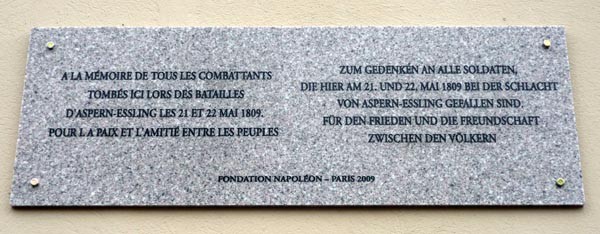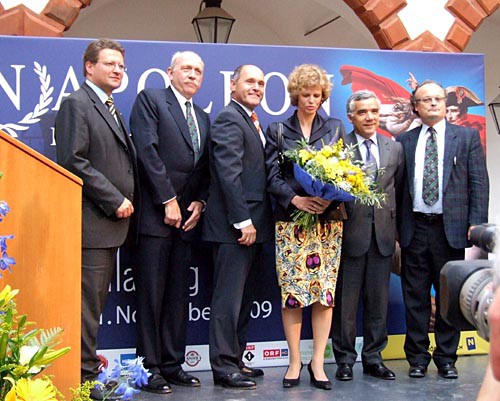Exhibition opening
In what turned out to be much more than a traditional exhibition inauguration ceremony, the Fondation Napoléon delegation was greeted by actors and musicians performing theatrical scenes and excerpts from Beethoven's Eroica, and informal, question-and-answer talks.
With Philippe Carré, French Ambassador to Austria, in attendance, first Matthias Pfaffenbichler, Curator at the Kunsthistorisches Museum and head curator of the exhibition, delivered a speech, followed by Sabine Haag, Director of the Kunsthistorisches Museum, and finally Victor-André Masséna, Prince d'Essling and President of the Fondation Napoléon, after which the exhibition was declared open. The exhibition's first weekend (16 – 17 May) saw the exhibition receive 4000 visitors.
Aspern, Essling and Wagram

With the Souvenir Napoléonien's correspondent in Austria, Robert Ouvrard, acting as guide, the delegation visited the battlefields of Aspern-Essling and Wagram. It was in the former village of Essling, part of the XXII district of Vienna (Leopoldau) since 1938, that the unveiling ceremony took place in the presence of municipal representatives from Vienna and members of the French embassy. The church, from the summit of which Masséna and Berthier observed the Austrian positions, and which was destroyed during the fighting, has since been rebuilt. Just opposite this church, mounted on the wall of a building still bearing the trace of a shot fired during the battle, is the commemorative plaque.
The plaque
 A translation of the speech, delivered in German by the Prince d'Essling before a clearly-moved audience, is available here in English:
A translation of the speech, delivered in German by the Prince d'Essling before a clearly-moved audience, is available here in English:
Ladies, Gentlemen, Friends, please believe me when I say that we did not wish today to be a celebration of the war.
Two hundred years ago this site was a place of chaos and pain.
Whilst it cannot be denied that a page of the history of France and Austria was written both here and further on at Deutsch Wagram, we must not forget that this history was written in the blood of the soldiers who took part in the combat.
Ever since that time, my family bears a title which was awarded by Napoleon to my ancestor for his action as commander of a corps of the Grande Armée on the 21st and 22nd May, 1809.
The emperor wanted to mark what we French call the victory at Essling.
On the same day, in the same place, in the same theatre of operations, the Austrian army under Erzherzog Karl won what you Austrians call the Battle of Aspern.
The very existence of this difference justifies the fact that, today in this place, we are remembering not the sound and fury of battle but the horror of war, and that we should do our duty by remembering and honouring those who, on both sides, gave their lives.
Today I am not addressing you as the Prince d'Essling but as President of the Fondation Napoléon.
Nor is this distinction mere sophistry.
The Fondation was created in 1987. It has two principal aims: to encourage interest and study in the two French empires in a European context and to help with the conservation of Napoleonic heritage.
In less than twenty years, it has achieved a privileged place amongst the historical institutions of France offering, for example, assistance to researchers, awarding book prizes and PhD research grants, playing a role in many different publications, and participating in conferences, study days and talks.
In conformity the aims of the Fondation Napoléon, and perfectly matching my own feelings on this matter, we are not celebrating a victory or commiserating with a defeat here.
Essling, Aspern and 1809 are now far behind us. And with the passing of the years, friendship between our two peoples has gradually grown, alongside a community of interest, not only between France and Austria but also within the context of a Europe, which slowly and sometimes painfully is approaching something resembling unity.
With this plaque we are not only marking history but we are also proclaiming that finally, after so much discord, we are finally ready to learn the lessons of the past.
Let us then, as French men and women, as Austrian women and men, as Europeans, share this moment of common history and let us work together for a continent in peace and for a closer union, which is the only way forward.
Long live Franco-Austrian friendship!
Long live peace!
(Tr. P.H. & H.D.W.)


